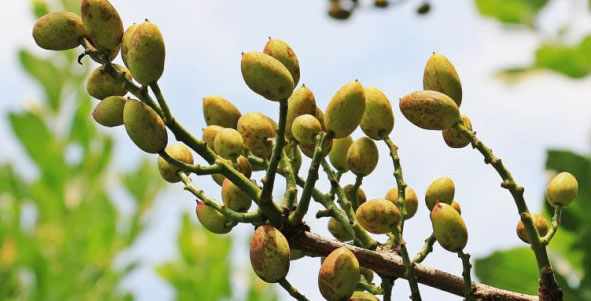Featuring our Pistachios – “The smiling nut”
- Category: Newsletter
Did you know that pistachios were part of the diet of Neanderthals more than 300,000 years ago (1)? It is a plant related to mango, poison ivy, and cashew. The pistachio plant (Pistacia vera) is dioecious, which means that there are separate male and female trees, both are necessary to produce nuts, but only the female trees will produce them. Interestingly, the female flowers have no petals, and thus pollination occurs by wind, not by bees (2).

Remarkably, pistachios are incredibly nutritious and beneficial for health. This nut is full of antioxidants that not only are key in supporting disease prevention but give them that unusual and characteristic green and purplish color. Eating a handful of pistachios, a day, has been proven to decrease levels of LDL or bad cholesterol, and help regulate glycemia (sugar blood levels), and hypertension among other benefits. They are recommended to reduce the prevalence of gestational diabetes, depression, Crohn’s disease, and inflammation. They are high in proteins, and dietary fiber, and a rich source of many vitamins, and minerals such as potassium and phenolic compounds (1,2).

Amazingly, pistachio shells, can be further used in the preparation of activated carbon electrodes, which are appropriate for use in Lithium-Sulfur (Li-S) batteries3. As the demand of energy grows, so does the need of energy sources that are independent and cleaner than the options provided by the petrochemical industry. These Li-S batteries are primarily used in the production of electric vehicles, a promising and environmentally friendlier option than petrol-based cars.
Thumbs up for the “Happy fruit”!!
References 1. Nezami, Esmaeil, and Pedro P. Gallego. 2023. "History, Phylogeny, Biodiversity, and New Computer-Based Tools for Efficient Micropropagation and Conservation of Pistachio (Pistacia spp.) Germplasm." Plants 12.2: 323 2. Ferguson, Louise, Vito Polito, and Craig Kallsen. 2005. "The pistachio tree; botany and physiology and factors that affect yield." Pistachio production manual, 4th ed. Davis, CA, USA, University of California Fruit & Nut Research Information Center: 31-39. 3. Benítez, Almudena, Julián Morales, and Álvaro Caballero. 2020. "Pistachio shell-derived carbon activated with phosphoric acid: A more efficient procedure to improve the performance of Li–S batteries." Nanomaterials 10.5: 840.


